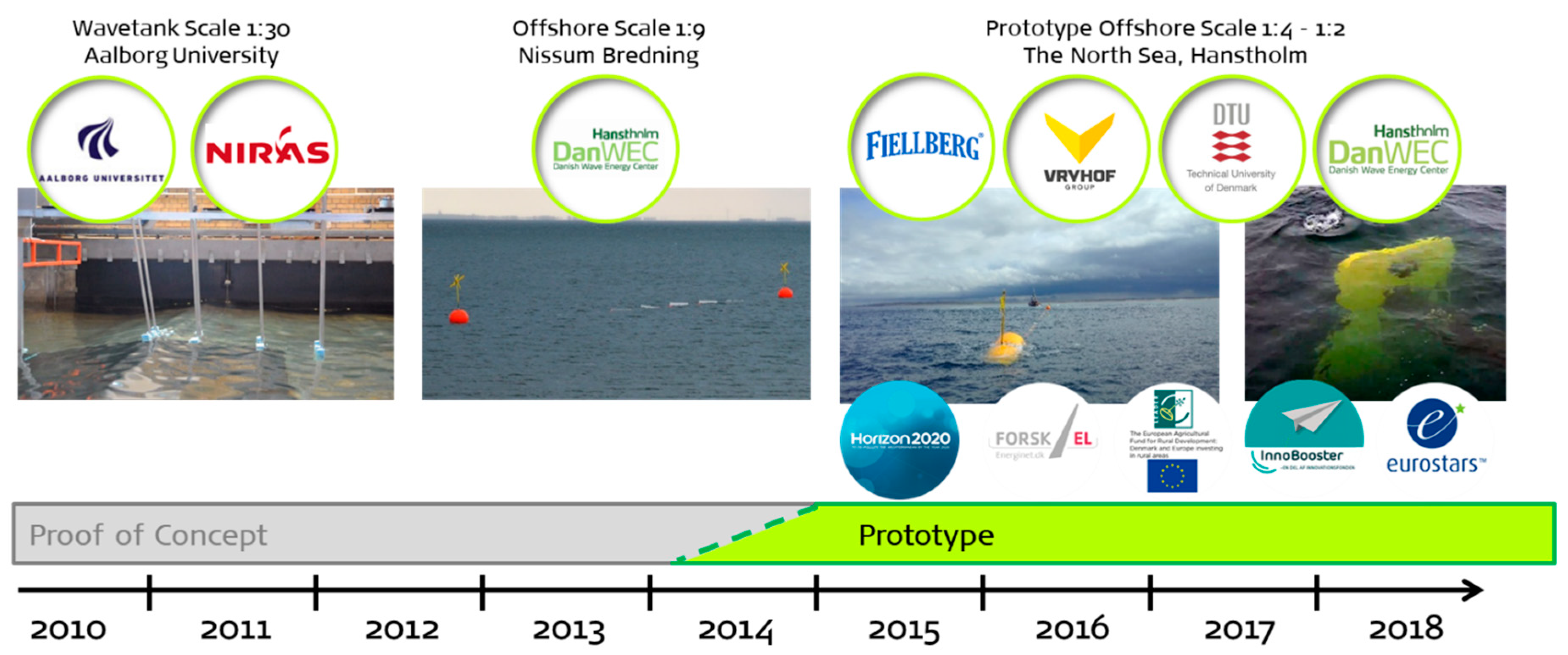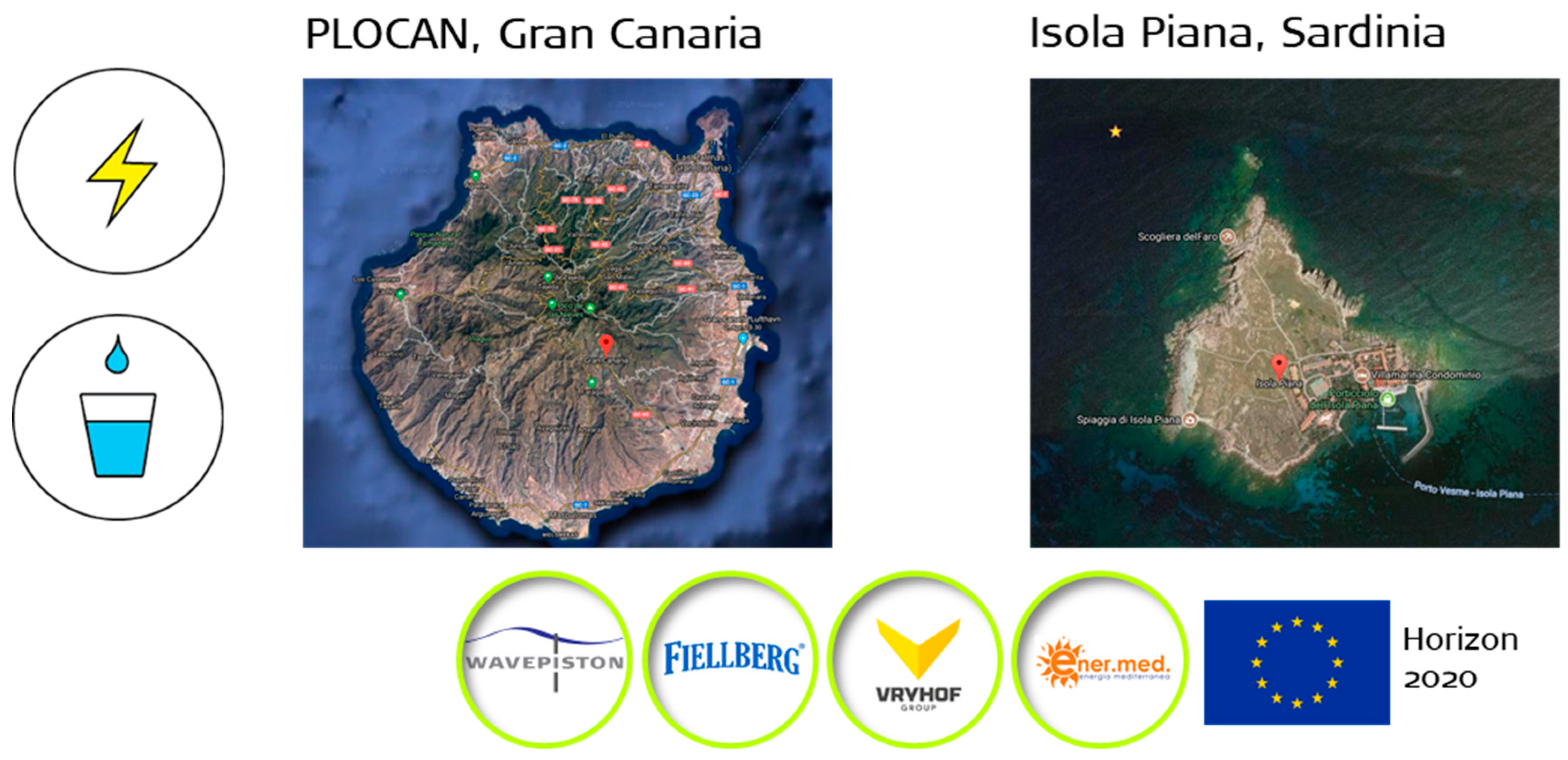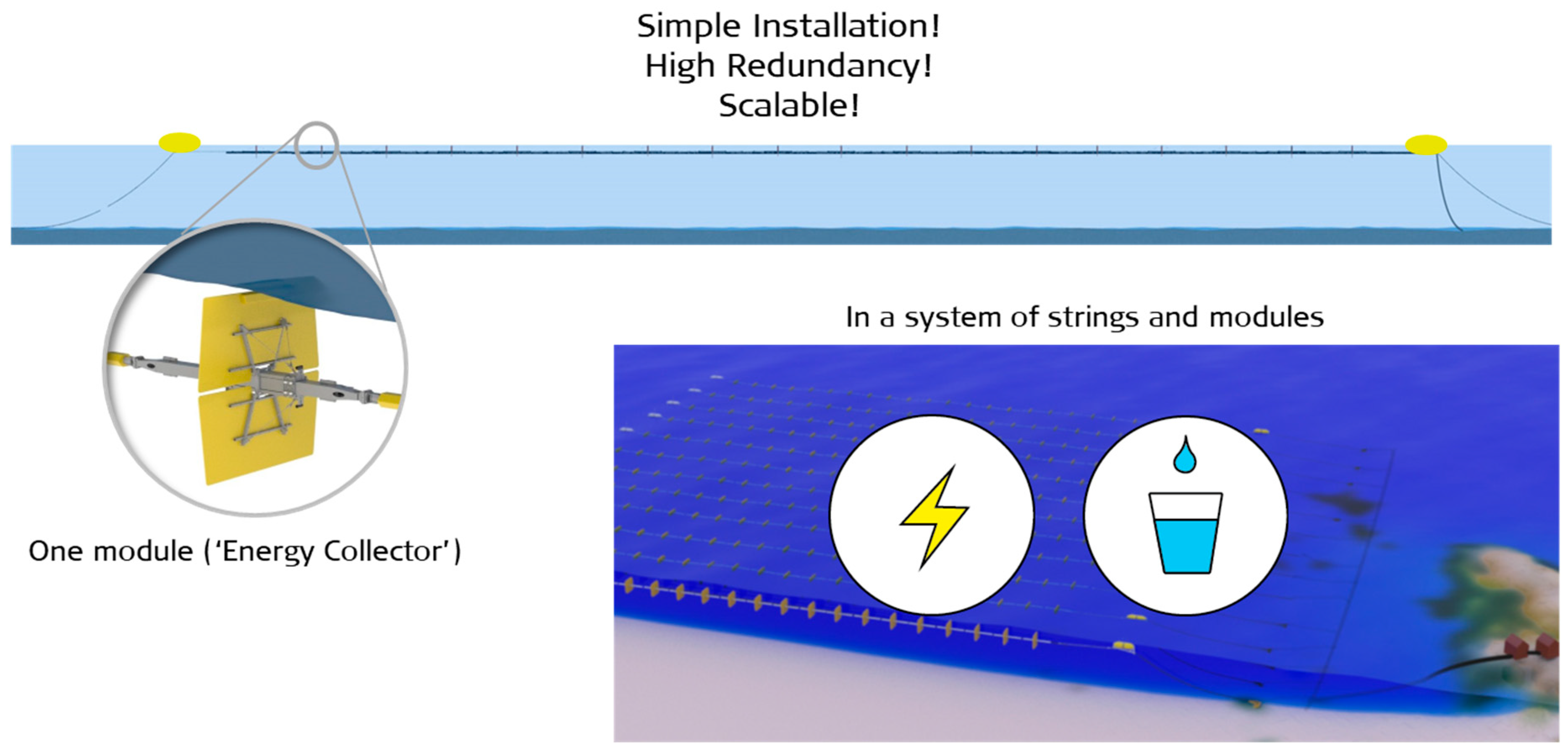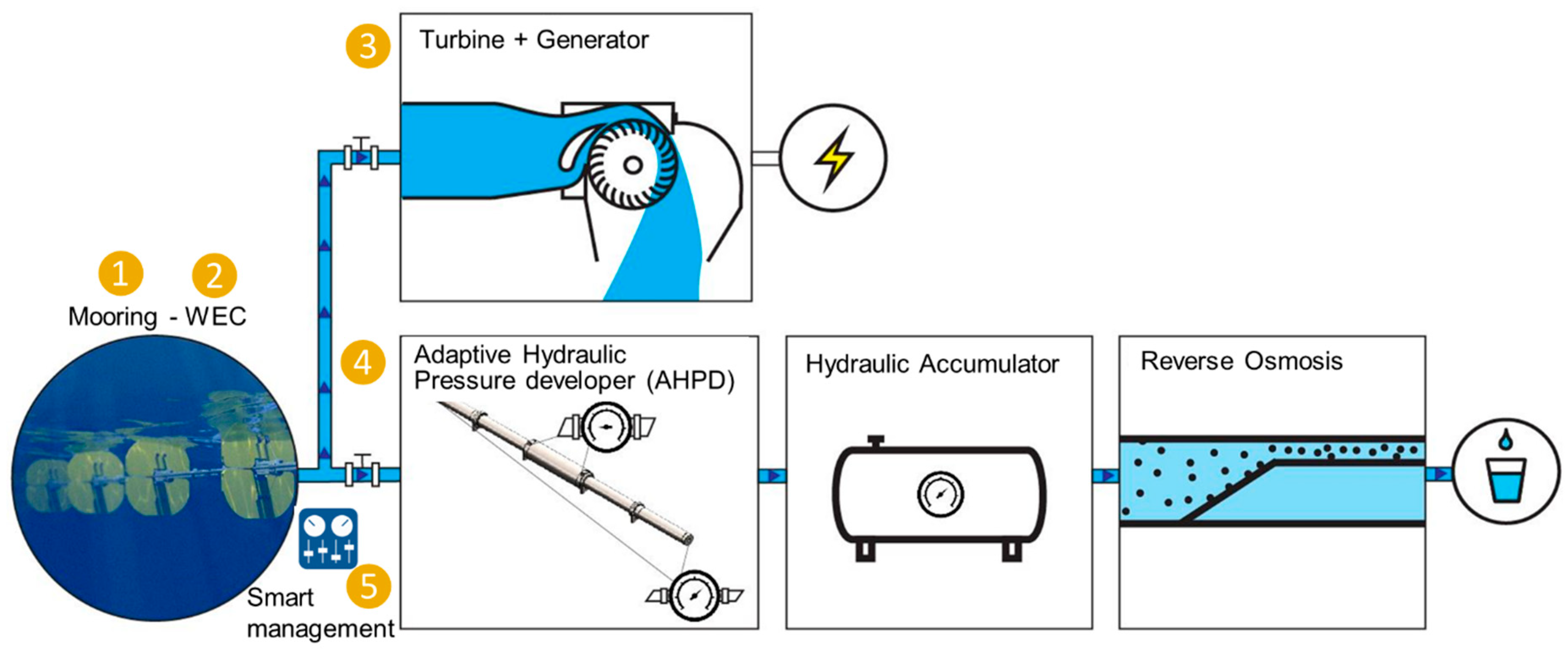New Combined Solution to Harness Wave Energy—Full Renewable Potential for Sustainable Electricity and Fresh Water Production †
Abstract
:1. Introduction
2. Concept, Methodology and State of Development
- A 1:30 prototype was tested in a wave tank at the University of Aalborg in irregular waves at 5 different wave states. The experimental results confirmed the system potential (energy calculations validated by Niras A/S, a large multidisciplinary consultancy company) and helped to define the strategy for further development;
- A 1:9 prototype was tested offshore, at the Nissum Bredning test centre, (limited fetch sea trial, i.e. small-scale waves). The system worked flawlessly and the 8 mounted energy collectors (ECs) maintained their efficiency during the test period without maintenance despite heavy biofouling and millions of wave cycles.
- In 2014, the consortium Vryhof, Fiellberg, the Technical University of Denmark and Wavepiston won a Danish national grant (ForskEL) to undertake a prototype project of the system in scale 1:2 testing in an open ocean environment (full fetch sea trial, in a very exposed wave climate). A version 1 of the prototype was installed in the North Sea at the DanWEC test site in August 2015. A version 2 of the prototype was installed in May 2017. A version 3 was installed in November 2018. The prototype has survived 7 m significant wave height, confirming the energy conversion efficiency and cost level of a commercial system. No adverse environmental impacts have been observed.

2.1. ForskEL Project (1:2 Scale Prototype Test in the North Sea)
2.1.1. Short Description
2.1.2. Project Objectives
- Objective 1: Development of a refined hydrodynamic model.
- Objective 2: Construction and test of a small-scale demonstration structure.
- Objective 3: Determination of the power production efficiency.
2.1.3. Project Results
- Results for Objective 1: The key results for Objective 1 are the Wavepiston load and energy tools. These tools allow both design loads and annual power production to be calculated for any site where the water depth and records for significant wave height, peak period and wave direction are available. The tool calculates the power based on an optimum or specified hydraulic pressure in the delivery pipe connected to each EC. The captured energy can be used in the business case for both electricity generation and desalination of pressurised water through reverse osmosis.
- Results for Objective 2: Detailed design and test of four consecutive versions of the energy collector ECs (Figure 4) for the Wavepiston system; detailed design and test of two consecutive versions of the buoys at each end of the string; detailed design of string assembly in three different versions; invention and detailed design of telescopic pump solution in the ECs; verification of the power performance simulated with the Wavepiston energy tool Construction and test of a small-scale demonstration structure.

- Results for Objective 3: the Wavepiston Energy Tool supports business case analysis by calculating the annual energy production AEP or amounts of desalinated water according to wave data and water depth from any type of site.
2.1.4. Utilization of Project Results


2.2. W2EW Project—Isola Piana (1:1 Scale)
2.2.1. Data on Location
2.2.2. Main Project Data
2.2.3. Short Description
2.2.4. Project Objectives
2.2.5. Project Expected Results
- Integrate and demonstrate a combined solution for zero-emissions electricity and water production, which will make it attractive to a wider range of customers;
- Reduce costs through the update of the components design as well as several sequential design cycles.
- Staged integration and deployment, where testing is carried out both at the components and system level, before final system integration and deployment, to reduce the risks of malfunctioning and ensure optimal integration;
- Demonstration at a European island of a full-scale prototype during 18 months in real life operational conditions to maximize the installation efforts and to build the required market confidence and awareness.
- Collection of solid a basis to advertise the economic and environmental benefits, critical to convince stakeholders of the added value of offered by the W2EW solution, remove negative perceptions related potential negative environmental impacts and to foster the development of commercial projects;
- Collection of data for life cycle assessment and qualification, to offer customers a demonstration of “fitness for service”, which is critical to speed up the permitting process of new installations and to reduce the risk profile and insurance costs;
- Strengthen market and regulatory intelligence.
3. The W2EW Consortium
- Wavepiston (DK, SME) has developed the WEC technology;
- Vryhof (NL, LE)—a world leader in large anchoring and mooring solutions;
- Fiellberg (FI, SME)—a manufacturer and supplier of customized hydraulic pumps technology, specialized in demanding marine, offshore and subsea applications.
- Ener.Med (IT, SME)—a supplier of electricity and developer of smart grid projects for the Italian market. The company has an extensive expertise in the energy planning, electrical energy market and on the implementation of installations for renewable energy production and smart management platforms.
4. Conclusions
Supplementary Materials
Funding
Conflicts of Interest
References
- IRENA. Wave Energy Technology Brief 4. June 2014. Available online: https://www.irena.org/documentdownloads/publications/wave-energy_v4_web.pdf (accessed on 10 April 2019).
- Ocean Energy Forum. Ocean Energy Strategic Roadmap 2016, Building Ocean Energy for Europe. 2016. Available online: https://webgate.ec.europa.eu/maritimeforum/sites/maritimeforum/files/OceanEnergyForum_Roadmap_Online_Version_08Nov2016.pdf (accessed on 1 November 2016).
- Spinoni, J.; Naumann, G.; Vogt, J.; Barbosa, P. Meteorological Droughts in Europe: Events and Impacts—Past Trends and Future Projections; Publications Office of the European Union: Luxembourg, 2016. [Google Scholar]
- United Nations World Water Assessment Programme. The United Nations World Water Development Report 2018: Nature-Based Solutions for Water. 2018. Available online: https://en.wikipedia.org/wiki/World_Water_Assessment_Programme (accessed on 23 July 2019).


| Description | U.M. | Quantity | Notes |
|---|---|---|---|
| Area | km2 | 0.21 | |
| Coastline | km | 1.8 | |
| Max altitude point | M | 1.9 | |
| Residential buildings | n. | 180 | |
| Peak of population | person | 400 | In summer season |
| Estimated energy consumption | MWh | 650 | |
| Estimated water consumption | m3 | 15,000 |
| Description | U.M. | Quantity | Notes |
|---|---|---|---|
| Project costs | M€ | 4.9 | |
| Project duration | Months | 32 | |
| Energy peak power generator | kW | 150 | |
| Estimated energy production | MWh | 280 | |
| Estimated fresh water production | m3 | 15,000 | |
| Number of strings | n. | 1 | |
| Length of string | m | 187 | |
| Distance to shore | m | 300–500 |
Publisher’s Note: MDPI stays neutral with regard to jurisdictional claims in published maps and institutional affiliations. |
© 2019 by the authors. Licensee MDPI, Basel, Switzerland. This article is an open access article distributed under the terms and conditions of the Creative Commons Attribution (CC BY) license (https://creativecommons.org/licenses/by/4.0/).
Share and Cite
Henriksen, M.; Piccioni, S.D.L.; Lai, M. New Combined Solution to Harness Wave Energy—Full Renewable Potential for Sustainable Electricity and Fresh Water Production. Proceedings 2019, 20, 10. https://doi.org/10.3390/proceedings2019020010
Henriksen M, Piccioni SDL, Lai M. New Combined Solution to Harness Wave Energy—Full Renewable Potential for Sustainable Electricity and Fresh Water Production. Proceedings. 2019; 20(1):10. https://doi.org/10.3390/proceedings2019020010
Chicago/Turabian StyleHenriksen, Michael, Simon Davide Luigi Piccioni, and Massimo Lai. 2019. "New Combined Solution to Harness Wave Energy—Full Renewable Potential for Sustainable Electricity and Fresh Water Production" Proceedings 20, no. 1: 10. https://doi.org/10.3390/proceedings2019020010
APA StyleHenriksen, M., Piccioni, S. D. L., & Lai, M. (2019). New Combined Solution to Harness Wave Energy—Full Renewable Potential for Sustainable Electricity and Fresh Water Production. Proceedings, 20(1), 10. https://doi.org/10.3390/proceedings2019020010





